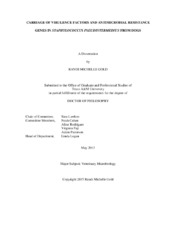| dc.contributor.advisor | Lawhon, Sara | |
| dc.creator | Gold, Randi | |
| dc.date.accessioned | 2015-09-21T16:47:31Z | |
| dc.date.available | 2017-05-01T05:35:46Z | |
| dc.date.created | 2015-05 | |
| dc.date.issued | 2015-02-12 | |
| dc.date.submitted | May 2015 | |
| dc.identifier.uri | https://hdl.handle.net/1969.1/155019 | |
| dc.description.abstract | Staphylococcus pseudintermedius is the most common microorganism isolated from canine pyoderma and opportunistic infections. Prevalence of methicillin-resistant S. pseudintermedius (MRSP) has increased and multi-drug resistance has become common. A total of 734 S. pseudintermedius isolates collected from dogs presented to the Veterinary Medical Teaching Hospital from 2007 to 2012 were studied. Isolates were analyzed for antimicrobial resistance and virulence gene carriage.
With the emergence of methicillin resistance, veterinarians have begun to use antimicrobials such as amikacin, to treat life-threatening MRSP infections. The most widespread mechanism of amikacin resistance is drug inactivation by aminoglycoside modifying enzymes (AMEs). The most prevalent gene detected here was aph(3′)- IIIa found in 75% (24/32) of isolates followed by aac(6′)/aph(2′′) and ant(4′)-Ia in 12% (4/32) and 3% (1/32), respectively. There was a significant association between amikacin and methicillin resistance. Since AMEs can be transferred from one bacteria to another, amikacin resistance may represent a new nosocomial and zoonotic threat.
Clindamycin is an alternative to β-lactam antimicrobial therapy for canine pyoderma. Inducible and constitutive resistance to clindamycin can occur. Approximately forty erm genes encoding methylases involved in clindamycin resistance have been reported, with ermB most commonly found among S. pseudintermedius. We found eight of 608 isolates tested, positive for inducible clindamycin resistance by D-test and PCR detection of ermB.
A vaccine against staphylococcal pyoderma would reduce the reliance on antimicrobial drugs. Staphylococcal cell-wall associated proteins (CWAPs) involved in colonization of the host are attractive potential vaccine targets. Eighteen CWAPs encoded by sps genes have been described in S. pseudintermedius; however, four vary in occurrence. Isolates were analyzed by polymerase chain reaction (PCR) for the presence of mecA, SCCmec type I-VI, and spsF, spsO, spsP, and spsQ. There was a significant association between methicillin resistance and carriage of spsP and spsQ. spsP and spsQ may be viable vaccine targets. | en |
| dc.format.mimetype | application/pdf | |
| dc.language.iso | en | |
| dc.subject | staphylococcus pseudintermedius | en |
| dc.subject | pyoderma | en |
| dc.subject | methicillin-resistant | en |
| dc.subject | amikacin resistance | en |
| dc.subject | inducible clindamycin resistance | en |
| dc.title | Carriage of Virulence Factors and Antimicrobial Resistance Genes in Staphylococcus pseudintermedius from Dogs | en |
| dc.type | Thesis | en |
| thesis.degree.department | Veterinary Pathobiology | en |
| thesis.degree.discipline | Veterinary Microbiology | en |
| thesis.degree.grantor | Texas A & M University | en |
| thesis.degree.name | Doctor of Philosophy | en |
| thesis.degree.level | Doctoral | en |
| dc.contributor.committeeMember | Cohen, Noah | |
| dc.contributor.committeeMember | Rodrigues, Aline | |
| dc.contributor.committeeMember | Fajt, Virginia R. | |
| dc.contributor.committeeMember | Patterson, Adam | |
| dc.type.material | text | en |
| dc.date.updated | 2015-09-21T16:47:31Z | |
| local.embargo.terms | 2017-05-01 | |
| local.etdauthor.orcid | 0000-0003-1226-7282 | |


